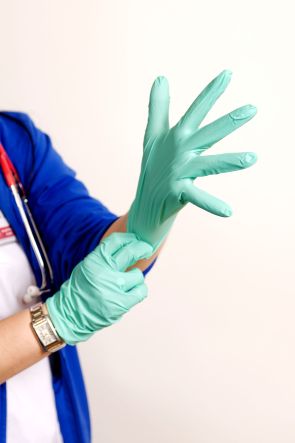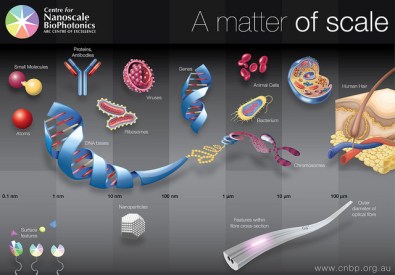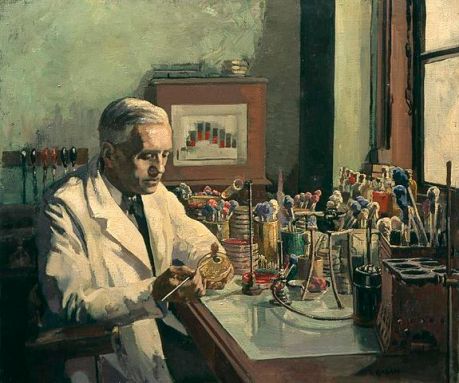Animals evolve strong defenses against predators. Predators evolve to better kill and catch their prey. Plants evolve defenses against insects. Insects evolve defenses against plants. We evolve defenses against bacteria. Bacteria evolve strategies against us.
And they are better at it than we are.
These rapidly reproducing organisms adapt to pharmaceuticals almost as fast as the industry can make them. Antibacterial drugs are outdated so quickly that it is almost not economical to develop new ones. Hospital patients are at risk of infection from a variety of antibacterial resistant bacteria.1 What can we do when these drugs are ceasing to work? We fight back with new innovations. Through chemistry, we have found a new way to approach the problem of bacterial evolution against antibiotics – and are building our nano-sized arsenal in preparation for the upcoming assault.

Nanomaterials bring some special properties to the fight against antibiotic-resistant bacteria. A nanometer is one billionth of a meter – 100,000 times smaller than a human hair. A nanomaterial is any material that is less than 100 nanometers (nm) in at least one dimension. It is precisely this scale that results in the interesting and unusual properties of nanomaterials. Think about this as three size levels with different properties: the atomic level (small) the nano level (medium) and the macroscopic level (large – and the level with which we are most familiar). Each of these levels has advantages and disadvantages. The nano level happens to be the one that reacts the best with cells because of the similar sizes involved. This nanoscale is unique and the target of our defenses against bacteria.

The Scottish biologist Alexander Fleming won the first battle against bacteria with the discovery of penicillin in 1928. An observant scientist, he noticed that a certain kind of mold prevented bacterial growth in the surrounding area. Scientists later determined that this antibiotic had prevented the bacteria from creating and repairing their cell walls, which are quite different from our human cell membranes. The disruption of normal cell wall repair occurs through chemical bonding between penicillin and the bacterial cell wall. This discovery was an enormous medical advance and meant that we no longer needed to fear infection from simple cuts and scrapes.

Unfortunately, the luxury of living in a time with antibiotics may be coming to an end. More and more species of bacteria are evolving drug resistance. The bacteria have had generations and generations of bacterial populations to evolve ways to create and repair their cell walls in spite of penicillin. Now it’s time to step up our game.
Scientists are creatively combatting the problem of antibacterial resistance using nanotechnology, in particular an antibacterial nanomaterial called graphene oxide.2 The “lead” in your pencil is actually graphite – two-dimensional sheets of carbon atoms bonded strongly in the horizontal direction and bonded weakly vertically, allowing it to flow nicely over your paper. One sheet of these strongly bonded carbon atoms is known as graphene. A sheet of graphene oxide is simply graphene with added oxygen atoms. (For more on graphite and graphene, you can see previous blog posts here and here.)

When you take a sheet of graphene oxide and cut it into small pieces (generally less than 100 nm in each dimension), you get a graphene oxide nanomaterial. This different form allows higher solubility in water. Thus, when graphene oxide is mixed in water it will stay suspended in the water much longer than graphene – and when it’s in the water, and not settled on the bottom, it’s available to battle the bacteria.
Graphene oxide is exciting as a possible antibiotic because it fights bacteria in a different way than penicillin. Whereas penicillin chemically binds to bacterial cell walls like super glue painfully binds your skin to an object you are repairing, graphene oxide is thought to mechanically damage bacterial walls by “popping” them with its sharp edges, akin to a needle popping a balloon.3 This “popping” is far harder to evolve strategies against than penicillin’s chemical binding, and opens the door for eco-friendly antibacterial coatings. This kind of coating could help stop the spread of infections in places like hospitals by preventing bacterial transfer from surfaces such as door knobs, light switches, phones, etc. Just as many buildings have spikes to prevent pigeons from landing, coatings with graphene oxide are like spikes to bacteria. Unfortunately, many medical coatings meant to reduce bacteria on surfaces currently use materials that can be toxic to the environment in high concentrations. Coatings made from graphene oxide are less toxic for various reasons, making this prevention more environmentally sustainable.

Graphene oxide also uses another mechanism of action to kill bacteria: the formation of reactive molecules.4 Scientists hypothesize that graphene oxide can form aggressively harmful chemicals that damage cell walls in a way that bacterial cells cannot repair, but which many other types of cells have evolved protections against. So with the physical “popping” mechanism of its sharp edges plus the formation of reactive chemicals, graphene oxide has double the potential for use in new antibacterial technology.
Bacteria have evolved many strategies to survive antibiotics. To combat the increasing number of antibiotic-resistant bacteria, scientists have turned to a new and growing technology – nanomaterials. Scientists have found that one particular nanomaterial, graphene oxide, has both mechanical and chemical properties which make it hazardous to bacteria, but relatively safe for humans. These dual-purpose materials that allow for both chemical and mechanical approaches on the bacterial battlefield hint that we are gaining the advantage. Using nanoscale science, we are fighting to keep pace with bacterial evolution and stay one step ahead of our single-celled foes.
EDUCATIONAL RESOURCES
- NOVA Teachers: Killer Microbes classroom resources & activity
- Public Health England: E-bug Antibiotics young adult resource pack
- Science buddies: Stopping Superbugs classroom activity
REFERENCES
- Centers for Disease Control (CDC). Superbugs threaten hospital patients (press release). March 3, 2016.
- Nanda, S., Yi, D., & Kim, K. Study of antibacterial mechanism of graphene oxide using Raman spectroscopy Scientific Reports6, Article number: 28443 (2016). doi: 1038/srep28443
- Akhavan, O. & Ghaderi, E. Toxicity of graphene and graphene oxide nanowalls against bacteria. ACS Nano 4, 5731–5736 (2010). Doi: 10.1021/nn101390x
- Liu, S. B. et al. Antibacterial activity of graphite, graphite oxide, graphene oxide, and reduced graphene oxide: membrane and oxidative stress. ACS Nano 5, 6971–6980 (2011). Doi: 10.1021/nn202451x
